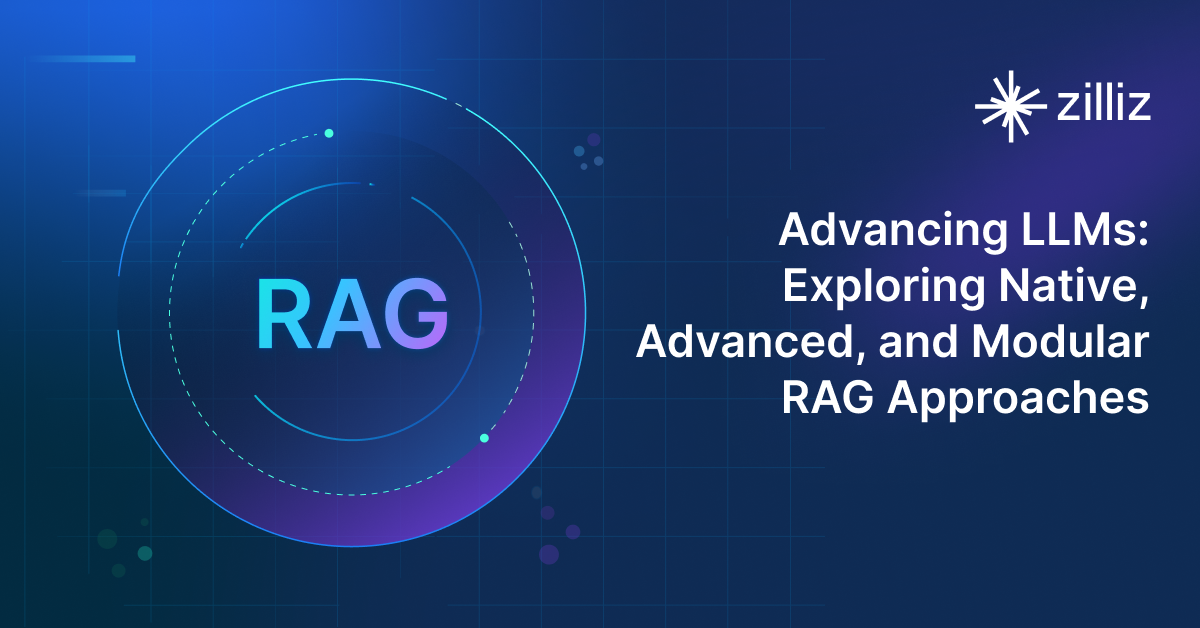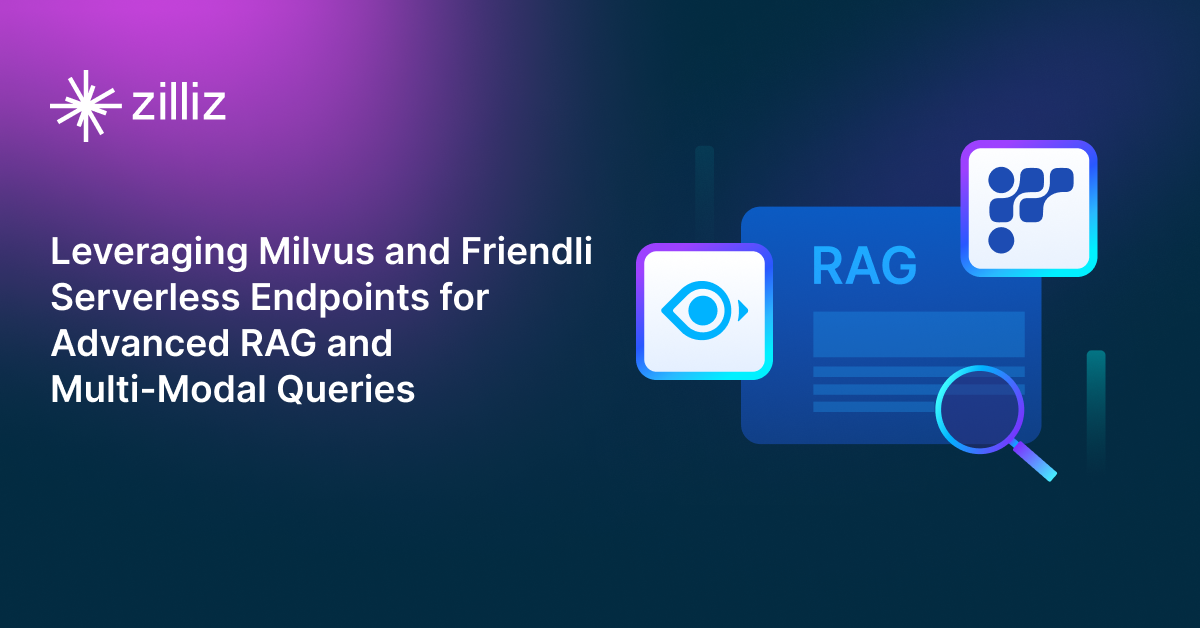Build RAG Chatbot with LangChain, Faiss, Groq llama3-70b-8192, and NVIDIA arctic-embed-l
Introduction to RAG
Retrieval-Augmented Generation (RAG) is a game-changer for GenAI applications, especially in conversational AI. It combines the power of pre-trained large language models (LLMs) like OpenAI’s GPT with external knowledge sources stored in vector databases such as Milvus and Zilliz Cloud, allowing for more accurate, contextually relevant, and up-to-date response generation. A RAG pipeline usually consists of four basic components: a vector database, an embedding model, an LLM, and a framework.
Key Components We'll Use for This RAG Chatbot
This tutorial shows you how to build a simple RAG chatbot in Python using the following components:
- LangChain: An open-source framework that helps you orchestrate the interaction between LLMs, vector stores, embedding models, etc, making it easier to integrate a RAG pipeline.
- Faiss: also known as Facebook AI Similarity Search, is an open-source vector search library that allows developers to quickly search for semantically similar multimedia data within a massive dataset of unstructured data. (If you want a much more scalable solution or hate to manage your own infrastructure, we recommend using Zilliz Cloud, which is a fully managed vector database service built on the open-source Milvus and offers a free tier supporting up to 1 million vectors.)
- Groq llama3-70b-8192: The llama3-70b-8192 model is a large language model developed by Meta, featuring 70 billion parameters and an 8,192-token context window. This model is designed for general-purpose language tasks, including text generation, summarization, and translation. Groq, a company specializing in AI hardware and software solutions, offers the llama3-70b-8192 model through its API. This integration allows developers to leverage Groq's high-performance Language Processing Unit (LPU) for efficient inference. Groq's LPU is known for its deterministic, single-core streaming architecture, which provides predictable and repeatable performance for AI workloads.
- NVIDIA arctic-embed-l: This AI model is designed for optimizing embedded systems with a focus on low-latency processing and energy efficiency. It excels in real-time applications, making it ideal for edge computing in smart devices, IoT applications, and automated systems, enabling advanced analytics and decision-making on-site.
By the end of this tutorial, you’ll have a functional chatbot capable of answering questions based on a custom knowledge base.
Note: Since we may use proprietary models in our tutorials, make sure you have the required API key beforehand.
Step 1: Install and Set Up LangChain
%pip install --quiet --upgrade langchain-text-splitters langchain-community langgraph
Step 2: Install and Set Up Groq llama3-70b-8192
pip install -qU "langchain[groq]"
import getpass
import os
if not os.environ.get("GROQ_API_KEY"):
os.environ["GROQ_API_KEY"] = getpass.getpass("Enter API key for Groq: ")
from langchain.chat_models import init_chat_model
llm = init_chat_model("llama3-8b-8192", model_provider="groq")
Step 3: Install and Set Up NVIDIA arctic-embed-l
pip install -qU langchain-nvidia-ai-endpoints
import getpass
import os
if not os.environ.get("NVIDIA_API_KEY"):
os.environ["NVIDIA_API_KEY"] = getpass.getpass("Enter API key for NVIDIA: ")
from langchain_nvidia_ai_endpoints import NVIDIAEmbeddings
embeddings = NVIDIAEmbeddings(model="snowflake/arctic-embed-l")
Step 4: Install and Set Up Faiss
pip install -qU langchain-community
from langchain_community.vectorstores import FAISS
vector_store = FAISS(embedding_function=embeddings)
Step 5: Build a RAG Chatbot
Now that you’ve set up all components, let’s start to build a simple chatbot. We’ll use the Milvus introduction doc as a private knowledge base. You can replace it with your own dataset to customize your RAG chatbot.
import bs4
from langchain import hub
from langchain_community.document_loaders import WebBaseLoader
from langchain_core.documents import Document
from langchain_text_splitters import RecursiveCharacterTextSplitter
from langgraph.graph import START, StateGraph
from typing_extensions import List, TypedDict
# Load and chunk contents of the blog
loader = WebBaseLoader(
web_paths=("https://milvus.io/docs/overview.md",),
bs_kwargs=dict(
parse_only=bs4.SoupStrainer(
class_=("doc-style doc-post-content")
)
),
)
docs = loader.load()
text_splitter = RecursiveCharacterTextSplitter(chunk_size=1000, chunk_overlap=200)
all_splits = text_splitter.split_documents(docs)
# Index chunks
_ = vector_store.add_documents(documents=all_splits)
# Define prompt for question-answering
prompt = hub.pull("rlm/rag-prompt")
# Define state for application
class State(TypedDict):
question: str
context: List[Document]
answer: str
# Define application steps
def retrieve(state: State):
retrieved_docs = vector_store.similarity_search(state["question"])
return {"context": retrieved_docs}
def generate(state: State):
docs_content = "\n\n".join(doc.page_content for doc in state["context"])
messages = prompt.invoke({"question": state["question"], "context": docs_content})
response = llm.invoke(messages)
return {"answer": response.content}
# Compile application and test
graph_builder = StateGraph(State).add_sequence([retrieve, generate])
graph_builder.add_edge(START, "retrieve")
graph = graph_builder.compile()
Test the Chatbot
Yeah! You've built your own chatbot. Let's ask the chatbot a question.
response = graph.invoke({"question": "What data types does Milvus support?"})
print(response["answer"])
Example Output
Milvus supports various data types including sparse vectors, binary vectors, JSON, and arrays. Additionally, it handles common numerical and character types, making it versatile for different data modeling needs. This allows users to manage unstructured or multi-modal data efficiently.
Optimization Tips
As you build your RAG system, optimization is key to ensuring peak performance and efficiency. While setting up the components is an essential first step, fine-tuning each one will help you create a solution that works even better and scales seamlessly. In this section, we’ll share some practical tips for optimizing all these components, giving you the edge to build smarter, faster, and more responsive RAG applications.
LangChain optimization tips
To optimize LangChain, focus on minimizing redundant operations in your workflow by structuring your chains and agents efficiently. Use caching to avoid repeated computations, speeding up your system, and experiment with modular design to ensure that components like models or databases can be easily swapped out. This will provide both flexibility and efficiency, allowing you to quickly scale your system without unnecessary delays or complications.
Faiss Optimization Tips
To enhance the performance of the Faiss library in a Retrieval-Augmented Generation (RAG) system, begin by selecting the appropriate index type based on your data volume and query speed requirements; for example, using an IVF (Inverted File) index can significantly speed up queries on large datasets by reducing the search space. Optimize your indexing process by using the nlist parameter to partition data into smaller clusters and set an appropriate number of probes (nprobe) during retrieval to balance between speed and accuracy. Ensure the vectors are properly normalized and consider using 16-bit or 8-bit quantization during indexing to reduce memory footprints for large datasets while maintaining reasonable retrieval accuracy. Additionally, consider leveraging GPU acceleration if available, as Faiss highly benefits from parallel processing, leading to faster nearest neighbor searches. Continuous fine-tuning and benchmarking with varying parameters and configurations can guide you in finding the most efficient setup specific to your data characteristics and retrieval requirements.
Groq llama3-70b-8192 optimization tips
To optimize Groq llama3-70b-8192 in a Retrieval-Augmented Generation (RAG) system, focus on efficient batch processing to maximize throughput by grouping multiple requests together. Utilize mixed precision for faster computation while maintaining model accuracy, and adjust input sequence length to strike a balance between context richness and computational efficiency. Leverage model parallelism to distribute workloads across multiple processing units, ensuring scalability. Regularly monitor GPU utilization and ensure that memory is efficiently managed by freeing unused tensors to prevent bottlenecks. Fine-tune the model on specific tasks or domains to improve accuracy and reduce inference time. Additionally, consider pruning or quantizing certain layers to optimize performance for production-level tasks without compromising too much on model output quality.
NVIDIA arctic-embed-l optimization tips
To optimize the NVIDIA arctic-embed-l component in your Retrieval-Augmented Generation (RAG) setup, consider implementing a multi-threading approach to parallelize data processing, which can significantly enhance throughput. Make use of mixed precision training to speed up the model's computations while minimizing memory usage. Regularly fine-tune your embeddings with domain-specific data to improve their relevance and accuracy. Additionally, leverage batch processing techniques to reduce latency and ensure efficient GPU utilization. Monitor your inference times and adjust the cache size dynamically based on workload patterns to balance speed and resource consumption effectively.
By implementing these tips across your components, you'll be able to enhance the performance and functionality of your RAG system, ensuring it’s optimized for both speed and accuracy. Keep testing, iterating, and refining your setup to stay ahead in the ever-evolving world of AI development.
RAG Cost Calculator: A Free Tool to Calculate Your Cost in Seconds
Estimating the cost of a Retrieval-Augmented Generation (RAG) pipeline involves analyzing expenses across vector storage, compute resources, and API usage. Key cost drivers include vector database queries, embedding generation, and LLM inference.
RAG Cost Calculator is a free tool that quickly estimates the cost of building a RAG pipeline, including chunking, embedding, vector storage/search, and LLM generation. It also helps you identify cost-saving opportunities and achieve up to 10x cost reduction on vector databases with the serverless option.
 Calculate your RAG cost
Calculate your RAG cost
What Have You Learned?
By diving into this tutorial, you’ve unlocked the power of building a RAG system from the ground up! You’ve seen how LangChain acts as the glue, seamlessly orchestrating interactions between components. By integrating FAISS as your vector database, you learned to store and retrieve embeddings efficiently, turning unstructured data into searchable knowledge. NVIDIA’s Arctic-Embed-L model transformed text into rich semantic vectors, ensuring your system understands context deeply. Then, Groq’s blazing-fast Llama3-70b-8192 stepped in as the LLM powerhouse, generating human-like answers grounded in the retrieved data. Together, these tools formed a dynamic pipeline that answers questions intelligently while staying rooted in your custom data—no more generic responses! You also picked up pro tips like optimizing chunk sizes for embeddings and balancing speed with accuracy, ensuring your RAG system isn’t just functional but exceptional. And let’s not forget the free RAG cost calculator—your secret weapon for budgeting resources without surprises.
Now, you’re equipped to build smarter, faster, and more scalable AI applications. Imagine the possibilities: chatbots that feel like experts, search engines that anticipate needs, or tools that democratize knowledge in your niche. This isn’t just about following steps—it’s about shaping the future of how humans and machines collaborate. So, fire up your IDE, experiment with different datasets, tweak those parameters, and watch your ideas come to life. The world of RAG is yours to explore, optimize, and redefine. Ready to leave your mark? Start building, iterate fearlessly, and let your creativity run wild. The next breakthrough could be just one prompt away—go make it happen! 🚀
Further Resources
🌟 In addition to this RAG tutorial, unleash your full potential with these incredible resources to level up your RAG skills.
- How to Build a Multimodal RAG | Documentation
- How to Enhance the Performance of Your RAG Pipeline
- Graph RAG with Milvus | Documentation
- How to Evaluate RAG Applications - Zilliz Learn
- Generative AI Resource Hub | Zilliz
We'd Love to Hear What You Think!
We’d love to hear your thoughts! 🌟 Leave your questions or comments below or join our vibrant Milvus Discord community to share your experiences, ask questions, or connect with thousands of AI enthusiasts. Your journey matters to us!
If you like this tutorial, show your support by giving our Milvus GitHub repo a star ⭐—it means the world to us and inspires us to keep creating! 💖
- Introduction to RAG
- Key Components We'll Use for This RAG Chatbot
- Step 1: Install and Set Up LangChain
- Step 2: Install and Set Up Groq llama3-70b-8192
- Step 3: Install and Set Up NVIDIA arctic-embed-l
- Step 4: Install and Set Up Faiss
- Step 5: Build a RAG Chatbot
- Optimization Tips
- RAG Cost Calculator: A Free Tool to Calculate Your Cost in Seconds
- What Have You Learned?
- Further Resources
- We'd Love to Hear What You Think!
Content
Vector Database at Scale
Zilliz Cloud is a fully-managed vector database built for scale, perfect for your RAG apps.
Try Zilliz Cloud for Free


